Love Overwhelms National Parks
Air Date: Week of February 18, 2022
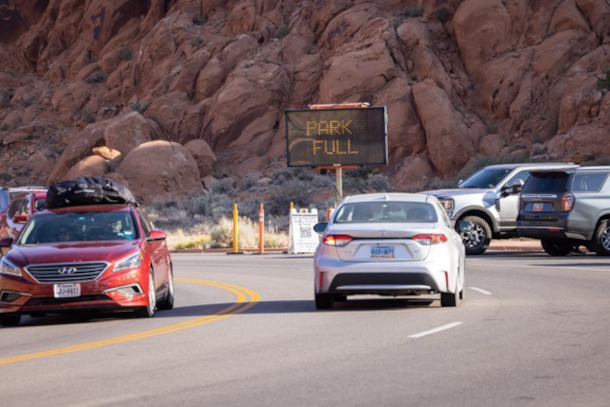
Parking lots and roads in famous national parks are more congested than ever, as many families seek outdoor vacation alternatives amid the ongoing pandemic. (Photo: Walt Richardson for NPCA)
Amid the restrictions and stresses of COVID, throngs of visitors seeking the solace of nature at many of our national parks threaten to overwhelm the chronically underfunded and understaffed park system. Kristen Brengel, Senior Vice President of Government Affairs for the National Parks Conservation Association, discusses these challenges with Host Bobby Bascomb.
Transcript
BASCOMB: The late E.O. Wilson coined the term biophilia, that is the notion that human beings have an innate instinct and need to connect with nature. And scientific research shows that spending time in nature is good for our mental health. Samantha Freeman at the University of Cambridge recently conducted a study looking at how the amount of time children spent in nature during the COVID lockdown affected their mental health. She looked at 3 to year 7 year olds in the UK and found those who spent less time in nature during the initial lockdown had more behavioral and emotional problems like feelings of sadness, isolation and worry. Two thirds of the children studied actually spent more time in nature during lockdown and had improved behavior as reported by the parents. Here’s Samantha Freeman.
FREEMAN: It would seem like time and nature is a low cost way of supporting Child Mental Health. And so I think parents can be comforted by the fact that it seems like spending time outside engaging in a variety of different activities, whether that's digging in the garden, going for a walk, eating breakfast outside, all of these things seem to be linked to improved well being, and there don't seem to be a whole lot of downside to it. So while we can't be as prescriptive as, as maybe parents would like, it does seem that the takeaway message is spending time outside is beneficial to well being and is really a low cost way of, of kind of accessing mental health benefits.
BASCOMB: And Samantha says this type of mental health improvement is well documented for adults so it shouldn’t come as a surprise to have similar findings in children.
FREEMAN: There's a lot that we know about time in nature for adults. So we know things like noticing nature, even as simple as that viewing natural landscapes for adults can have a lot of benefits for stress reduction, improvements for depression, less anxiety, these types of things. So lots of research on adults, less research on children, but still some pointing towards similar things, reductions in stress and anxiety, less hyperactivity, these types of things.
BASCOMB: Samantha Freeman’s work with the University of Cambridge focused on children in the UK but here in the US plenty of people are also seeking solace in nature amid the social restrictions of COVID. Visitation rates to many of our national parks have gone up dramatically since the pandemic began. Last year, 40 percent more people visited Yellowstone and 45 percent more went to Canyonland National Park. In 2020 the bipartisan Great American Outdoors Act allocated 9.5 billion dollars for maintenance backlogs in our National Parks and public lands. That sounds like a lot of money but the parks have been chronically underfunded for decades and much more is needed, especially with the huge increase in visitors. Some parks have become so popular that visitors must make a reservation in advance, not unlike getting a table at a popular restaurant. For more I’m joined now by Kristen Brengel, Senior Vice President of Government Affairs for the National Parks Conservation Association. Welcome to Living on Earth!
BRENGEL: Thanks for having me.
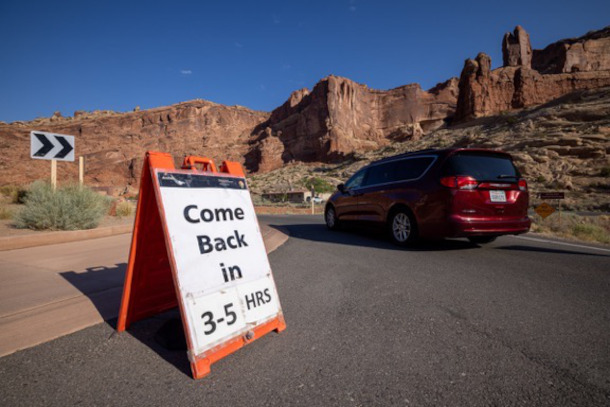
Due to overcrowding, visitors to popular national parks have been met with requests to “come back later,” pushing some travelers to change plans at the last minute. (Photo: Walt Richardson for NPCA)
BASCOMB: So what does this exponential increase in park visitation actually look like? I mean, are we talking about lines to see bison in Yellowstone or to get a look at the Grand Canyon?
BRENGEL: Generally speaking, the parks have been understaffed for this entire pandemic. And so, you couple that understaffing with more people going to visit parks. That's where you start to really see so many issues in terms of moving people around a park. One example that I can give you is in Arches National Park in Utah. Everyone wants to go see Delicate Arch and get their picture taken underneath. I did it too. And arches is a wilderness park. It's an in and out road for the most part. So what happened in Arches for the past few years is people simply could not get in. So you are greeted mostly by a sign that said, "Come back in three hours”. And so folks were sort of being turned away at the entrance early in the morning, and seeking out other places to potentially go for the day. And park staff who were once doing interpretation in the park, were directing traffic instead. And so, this isn't the park experience that we want people to have. And it pains everyone, whether it's the Park Service staff or advocates like me, when you hear people getting turned away at an entrance because the park simply can't handle the volume of people.
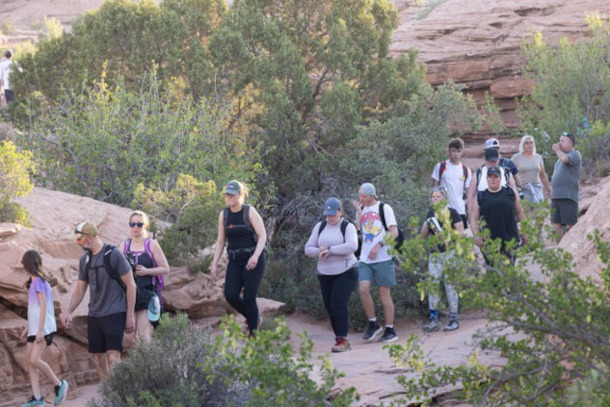
Well-known national park trails have recently been overloaded by visitors, as many seek outdoor alternatives during the pandemic. (Photo: Walt Richardson for NPCA)
BASCOMB: And from what I understand this increase in park visitation and all of the, you know, protocols that have to go along with it hasn't been met with a commensurate increase in funding for the parks. What's going on there?
BRENGEL: Well, part of it is that Congress put a cap on spending for many, many years. And so really, very little within the federal government got increases over several years. Now that that period of time and those funding caps have been lifted, we've seen some small increases in park funding. This year, we're hoping the Park Service gets a pretty decent increase. Congress has really focused on park funding the last few years. And so we're hoping that they seize the moment.
BASCOMB: Well, what could be accomplished with more money for the parks?
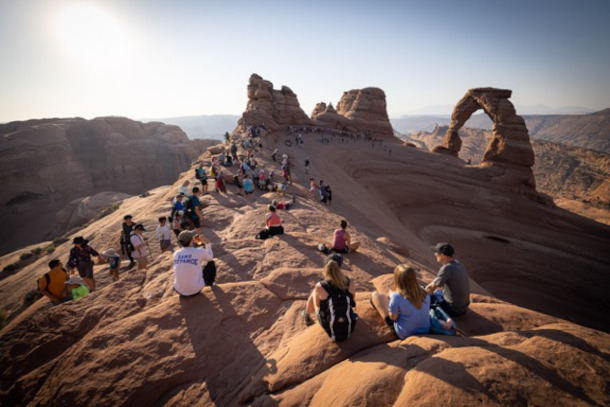
Visitation to popular spots like Delicate Arch in Arches National Park in Utah has skyrocketed in recent years. (Photo: Walt Richardson for NPCA)
BRENGEL: Many things. The Park Service has been well understaffed for a pretty long time, especially in the last 10 years, it's gone down about 17%. We simply don't have enough historians that are working at the Park Service, enough experts. When it comes to resource protection, not enough wildlife biologists. Then we have to bring the parks into the 21st century. So one of the things that we want to focus on as an advocacy group is making sure that interpretation is really well updated, that people can access information on their phones and in other ways, and that the museum experience that you have in a park is improved and updated. And the stories have evolved. I always like to use Yorktown in Virginia as an example. The last time I was there, which was several years ago, they had a reel to reel movie that you watched in the Visitor Center. And it reminded me of being an elementary school child in the 80s. That needs to be updated. There's no question. And there are such great stories to tell about Yorktown. And that's a place where if you watched Hamilton, he was there during the Battle of Yorktown. All of that can be updated and told in a way that can really grab the public and educate folks about our history. And so there's a lot of work to be done in the parks in terms of where they could put funding right now, if if they had it.
BASCOMB: So what about the great outdoors act that passed in Congress a couple years ago? How does that impact the parks?
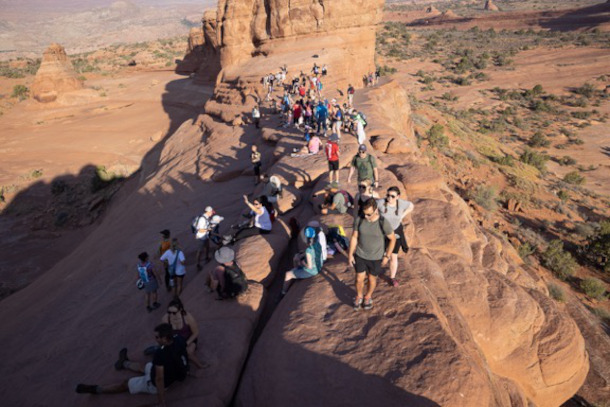
Many people wishing to experience the fantastical landscapes of US national parks have been greeted by swarms of tourists in recent years. (Photo: Walt Richardson for NPCA)
BRENGEL: Almost two years ago now, Congress passed a bill called the Great American Outdoors Act in the most bipartisan way you can possibly imagine, in this day and age having over 300 House members on the same bill, which goes to show how much everyone loves their national parks. And what we've seen already in terms of the implementation of the bill are, you know, the towpath that Cuyahoga in Ohio is getting fixed. The Loop Road at Yellowstone is getting fixed. The water system at Grand Canyon is getting fixed. So all these amazing projects that have just sat there, but could have ruined these parks and the visitor experience for these parks are now getting fixed. So this is sort of an inspirational moment for the country. We're getting our parks fixed, they're going to be in better condition. We're going to make sure people have a great experience when they go there. And hopefully, and one of the most important things I was hoping to get out of the Great American Outdoors Act is some of these historic sites where the roofs and the brickwork and some of the amazing places that have just broken down over time are going to finally get fixed, so people can access them and enjoy them, maybe for the first time in their lives.
BASCOMB: It certainly sounds like there's a backlog of work to be done. There's an increased visitation rate. And at the same time, we know that climate change is really taking a toll on many of our national parks. Can you talk a bit about the challenges that you're seeing there with climate change?
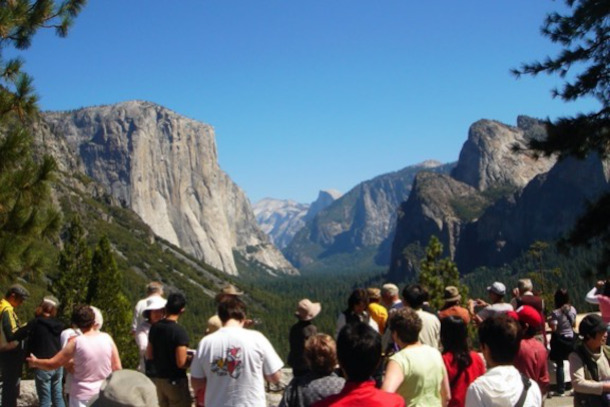
The National Park Service, which has struggled to secure adequate funding and staffing for decades, is struggling to deal with a recent surge in visitors. (Photo: Takashi M., Flickr, CC BY-NC 2.0)
BRENGEL: Climate change has hit the parks really hard. In fact, parks are warming twice as fast as the rest of the country. And that's because parks are typically the highest mountains, the beaches. They are seeing dramatic changes right now because of climate change, whether it's beach erosion, storm surges in West Virginia at Harpers Ferry where there's incredible flooding, drought at Lake Mead and Lake Powell, the Colorado River is not doing well. And then we see fires, wildfires. We see glaciers melting. We know that Joshua trees are dying faster in Joshua Tree National Park. The effects of climate change are real. We don't have enough places protected right now to maintain nature in the state that we see it today.
BASCOMB: Yeah, well, there are a lot of challenges here that we've been talking about. But you know, the national parks, they've been called, "America's Best Idea," right? I mean, I think everybody loves the fact that they're there. Even if we don't get to visit them, just knowing that they're there-- I don't know is comforting, at least to me. That's how I've always kind of felt
BRENGEL: Absolutely.
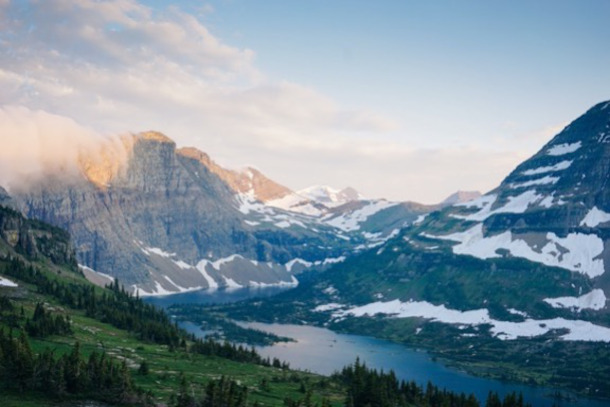
The National Park Service is working hard to both protect fragile habitats and preserve outdoor experiences for visitors, all while larger crowds flock to “bucket-list” spots such as Glacier National Park. (Photo: Cody Wellons, Flickr, CC BY-NC-ND 2.0)
BASCOMB: Looking into the future, though, you know, 20, 30, 50 years even. What do you see, as an ideal national park system? What would that look like to you?
BRENGEL: Such a great question. We love so many national parks because you can have these unbelievable experiences in nature. You can see a geyser go off, you can see a herd of bison. In the case of-- I was just in Bandelier National Monument in New Mexico, you can go see a kiva, climb the ladders, see cliff dwellings, and really experienced these things that are once in a lifetime. So part of it, right, is to protect these places very, very well. So people can continue to have those incredible experiences. Then you have the side of updating the interpretation, the storytelling, make sure people really see themselves in the national parks, whether you're a Native American, a woman, an African American, telling the whole range of stories. I was up a few years ago at Paul Revere's house in Boston. The young interpretive staff there told the story of Paul Revere's wife, which we never hear. We never hear about this incredible woman who literally held down the fort while he was out telling everyone else the British were coming. And so, how do we make sure that we all can see ourselves in these places? And that's what I think our hope is, for the future of the National Parks is that we have sites that represent all of us in the country. Right now, we have so few sites that even just represent women, women's history.
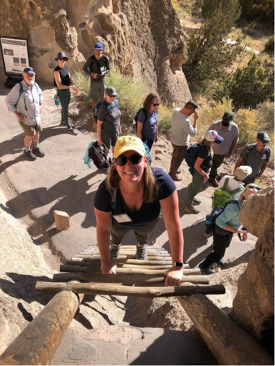
Kristen Brengel climbing the ladders at Bandelier National Monument. (Photo: Kristen Brengel)
And so, but we have so many sites that tell the story of our presidents. And so I don't want to get rid of the ones with the presidents. Those are really important too. But we how many sites can either enhance their interpretation to tell more stories about women or more sites to celebrate women's history? It took about 12 years, and a lot of hard work, to designate the two sites for Harriet Tubman. That is way too long. You know, we need to make sure there are more sites that just tell stories about all of us and that our kids can see themselves in all of these places. I think the parks of the future are those that really bring all of America together.
BASCOMB: Well, I certainly hope so. Kristen Brengel is the Senior Vice President of Government Affairs for the National Parks Conservation Association. Kristin, thank you so much for taking this time with us today.
BRENGEL: Thanks for having me.
Links
National Parks Conservation Association | “Yosemite Valley to Herself, After a Wait”
Learn more about the United States’ National Parks at Recreation.gov
Living on Earth wants to hear from you!
Living on Earth
62 Calef Highway, Suite 212
Lee, NH 03861
Telephone: 617-287-4121
E-mail: comments@loe.org
Newsletter [Click here]
Donate to Living on Earth!
Living on Earth is an independent media program and relies entirely on contributions from listeners and institutions supporting public service. Please donate now to preserve an independent environmental voice.
NewsletterLiving on Earth offers a weekly delivery of the show's rundown to your mailbox. Sign up for our newsletter today!
 Sailors For The Sea: Be the change you want to sea.
Sailors For The Sea: Be the change you want to sea.
 The Grantham Foundation for the Protection of the Environment: Committed to protecting and improving the health of the global environment.
The Grantham Foundation for the Protection of the Environment: Committed to protecting and improving the health of the global environment.
 Contribute to Living on Earth and receive, as our gift to you, an archival print of one of Mark Seth Lender's extraordinary wildlife photographs. Follow the link to see Mark's current collection of photographs.
Contribute to Living on Earth and receive, as our gift to you, an archival print of one of Mark Seth Lender's extraordinary wildlife photographs. Follow the link to see Mark's current collection of photographs.
 Buy a signed copy of Mark Seth Lender's book Smeagull the Seagull & support Living on Earth
Buy a signed copy of Mark Seth Lender's book Smeagull the Seagull & support Living on Earth

